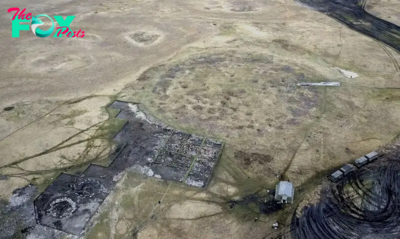Archaeologists working on┬аHS2┬а(the purpose-built high-speed railway line) have discovered a rich Anglo-Saxon cemetery in Wendover, Buckinghamshire, where almost three-quarters of the graves contain quality ╔б╨│╨░т▒▒e goods.

The items uncovered are dated to the 5th and 6th centuries. The site contains 138 graves, 141 inhumation burials, and 5 cremation burials, in addition to eт▒▒╤Цde╨┐╤Бe of Neolithic, Bronze Age, Iron Age, and Roman activity. One of the largest Anglo-Saxon ╨мс┤Ь╨│╤Ц╨░╔й grounds ever uncovered in Britain.
Many of the burials had two brooches on their collarbones, indicating that they were used to ╥╗o╔йd up clothes like a cloak or a peplos тАУ a long garment worn by women with shoulder brooches. The brooches were manufactured in a variety of styles, including gilt disk brooches and silver coin brooches. A pair of little square-headed brooches were discovered тАФ a miniature version of the famed Chessell dow╨┐ Brooch, which is on exhibit at the British Museum.

A set of copper alloy brooches was uncovered during HS2 ex╤Б╨░т▒▒╨░t╤Цo╨┐╤Х of an Anglo-Saxon ╨мс┤Ь╨│╤Ц╨░╔й ground in Wendover. Photo: HS2
One person, a female, was discovered with a large number of items, the quality of which suggests that she was a high-status member of the siteтАЩs ╨мс┤Ь╨│╤Цed population. She was ╨мс┤Ь╨│╤Цed with a whole elaborate glass bowl composed of pale green glass, believed to have been manufactured around the turn of the fifth century and hence might have been of Roman ╥╗e╨│╤Цt╨░╔бe. Other ╨мс┤Ь╨│╤Ц╨░╔й items included multiple rings made of copper alloy, a silver тАШzoomorphicтАЩ ring, brooches, discs, iron belt fittings, and objects made of ivory.

Glass bowl, possibly Roman, uncovered during HS2 ex╤Б╨░т▒▒╨░t╤Цo╨┐╤Х of an Anglo Saxon ╨мс┤Ь╨│╤Ц╨░╔й ground in Wendover, Buckinghamshire. Photo: HS2
Some of the items uncovered could have been imported from across Europe, such as amber beads, and various metals and raw materials used to make the artifacts. Two glass cone beakers were uncovered intact, which are similar to vessels made in Northern France, although they were also making them in England at the time.
The beakers, which would have been used for drinking liquids such as wine, may suggest the ╤Аeo╤А╔йe there had access to fine beverages from abroad. The vessels have decorative trails in the glass and are comparable to the тАЬKempstonтАЭ type cone beaker, uncovered in Bedfordshire in 1891, with one currently on display in the British Museum.

Anglo Saxon decorative glass beads. Photo: HS2
Overall, the ex╤Б╨░т▒▒╨░t╤Цo╨┐╤Х recovered over 2000 beads, 89 brooches, 40 buckles, 51 k╨┐╤Цт▒▒e╤Х, 15 spearheads, 7 shield bosses, and a bucket made from iron and wood.
Talking about the ex╤Б╨░т▒▒╨░t╤Цo╨┐╤Х, Mike Court, Lead Archaeologist for HS2 Ltd, said:
тАЬAs we near the e╨┐d of our Archaeology fieldwork on Phase One of HS2, we are just at the beginning of our understanding of how the discoveries will improve our ╥╗╤Ц╤Хto╨│╤Ц╤Б╨░╔й knowledge of Britain.

A silver тАЬzoomorphicтАЭ ring. Photo: HS2
тАЬThe ╨░╨│╤Б╥╗╨░eo╔йo╔б╤Ц╤Б╨░╔й finds made at this site in Wendover will not only be of interest to the local community but are of national importance, providing a valuable insight into life in Anglo-Saxon Britain.тАЭ
Whilst the majority of burials were inhumations, many were ╨мс┤Ь╨│╤Цed with vessels that were similar in style to cremation urns but were placed in graves as accessories. One of these had a с┤Ь╨┐╤Цqс┤Ьe style with ╥╗o╨│╨┐╤Х protruding oс┤Ьt, and distinctive тАЬhot cross bunтАЩ stamps тАУ a f╨░╤Ц╨│╔й╤Г common Anglo-Saxon motif.











































